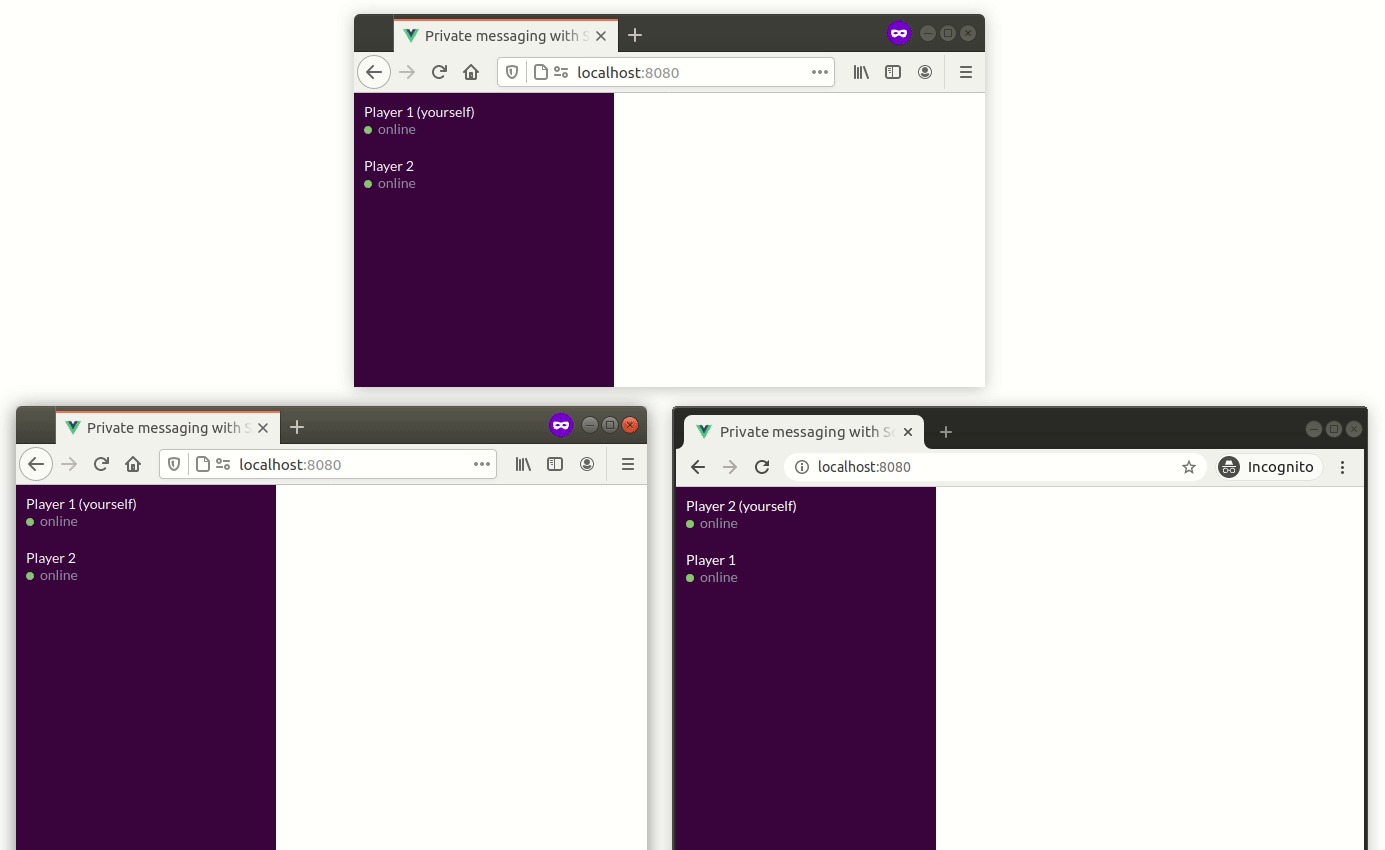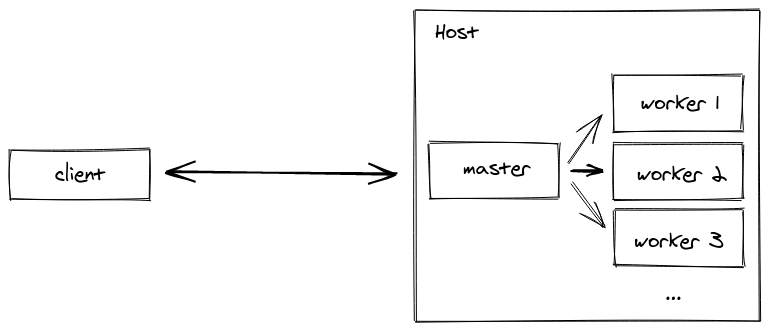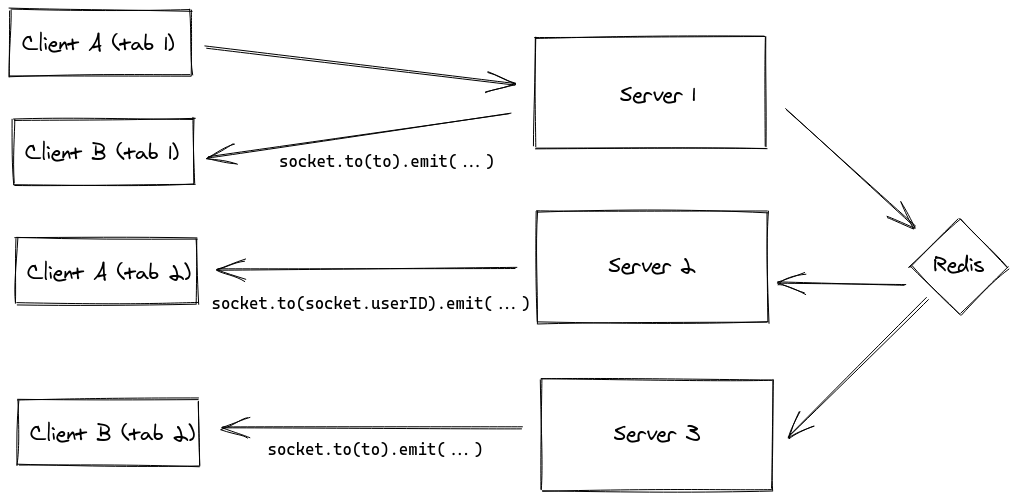私人訊息 - 第四部分
本指南分為四個不同的部分
以下是我們在第三部分結束時的狀況

現在我們將了解如何擴充到多個 Socket.IO 伺服器,以達到高可用性/負載平衡的目的。
安裝
讓我們查看第四部分的分支
git checkout examples/private-messaging-part-4
以下是您應該在目前目錄中看到的內容
├── babel.config.js
├── package.json
├── public
│ ├── favicon.ico
│ ├── fonts
│ │ └── Lato-Regular.ttf
│ └── index.html
├── README.md
├── server
│ ├── cluster.js (created)
│ ├── docker-compose.yml (created)
│ ├── index.js (updated)
│ ├── messageStore.js (updated)
│ ├── package.json (updated)
│ └── sessionStore.js (updated)
└── src
├── App.vue
├── components
│ ├── Chat.vue
│ ├── MessagePanel.vue
│ ├── SelectUsername.vue
│ ├── StatusIcon.vue
│ └── User.vue
├── main.js
└── socket.js
完整的 diff 可在此找到。
更新伺服器
對於最後一部分,我們需要在伺服器端新增 3 個依賴項
ioredis:一個很棒的 Redis 用戶端socket.io-redis:一個基於 Redis 發布/訂閱機制的 Socket.IO 轉接器@socket.io/sticky:一個在 Node.js 叢集中執行 Socket.IO 的模組
我們也需要一個 Redis 實例。為了您的方便,提供了一個 docker-compose.yml 檔案
cd server
docker-compose up -d
npm install
npm start
這將建立 4 個 Node.js 工作人員,每個工作人員執行相同的 index.js 檔案。
在客戶端方面,不需要任何變更,我們將在此專注於伺服器端。
運作方式
建立多個伺服器
在建立多個 Socket.IO 伺服器時,有兩件事要做
- 您需要啟用 sticky-session(請參閱 這裡 以取得完整說明)
- 您需要將預設的記憶體中介接頭替換為 Redis 中介接頭(或其他相容的中介接頭)
在我們的範例中,@socket.io/sticky 模組用於確保來自特定客戶端的請求始終路由到同一個 Socket.IO 伺服器。這就是所謂的「sticky-session」

注意:我們也可以建立多個監聽不同埠的程序(或使用多個主機),並在它們前面新增一個反向代理程式。在 文件 中涵蓋了為常見的反向代理程式解決方案(例如 NginX 或 HAProxy)啟用 sticky-session。
叢集建立在 server/cluster.js 檔案中
const cluster = require("cluster");
const http = require("http");
const { setupMaster } = require("@socket.io/sticky");
const WORKERS_COUNT = 4;
if (cluster.isMaster) {
console.log(`Master ${process.pid} is running`);
for (let i = 0; i < WORKERS_COUNT; i++) {
cluster.fork();
}
cluster.on("exit", (worker) => {
console.log(`Worker ${worker.process.pid} died`);
cluster.fork();
});
const httpServer = http.createServer();
setupMaster(httpServer, {
loadBalancingMethod: "least-connection", // either "random", "round-robin" or "least-connection"
});
const PORT = process.env.PORT || 3000;
httpServer.listen(PORT, () =>
console.log(`server listening at https://#:${PORT}`)
);
} else {
console.log(`Worker ${process.pid} started`);
require("./index");
}
在我們現有的 server/index.js 檔案中,有一個變更:工作人員程序建立的 HTTP 伺服器實際上不會監聽特定埠,請求將由主程序處理,然後轉發到正確的工作人員。
之前
httpServer.listen(PORT, () =>
console.log(`server listening at https://#:${PORT}`)
);
之後
setupWorker(io);
@socket.io/sticky 提供的 setupWorker 方法將負責主程序和工作人員之間的同步。
階段和訊息
現在已啟用 sticky-session,我們需要在 Socket.IO 伺服器之間共用階段和訊息。
我們建立一個基於 Redis 的新 SessionStore。我們將每個階段儲存在 Redis hash 中,並使用 HSET 命令
class RedisSessionStore extends SessionStore {
// ...
saveSession(id, { userID, username, connected }) {
this.redisClient
.multi()
.hset(`session:${id}`, "userID", userID, "username", username, "connected", connected)
.expire(`session:${id}`, SESSION_TTL)
.exec();
}
// ...
}
我們還設定金鑰的過期時間,以清除舊階段。
使用 HMGET 指令擷取階段非常簡單
const mapSession = ([userID, username, connected]) =>
userID ? { userID, username, connected: connected === "true" } : undefined;
class RedisSessionStore extends SessionStore {
// ...
findSession(id) {
return this.redisClient
.hmget(`session:${id}`, "userID", "username", "connected")
.then(mapSession);
}
// ...
}
擷取所有階段則稍微複雜一點
class RedisSessionStore extends SessionStore {
// ...
async findAllSessions() {
// first, we fetch all the keys with the SCAN command
const keys = new Set();
let nextIndex = 0;
do {
const [nextIndexAsStr, results] = await this.redisClient.scan(
nextIndex,
"MATCH",
"session:*",
"COUNT",
"100"
);
nextIndex = parseInt(nextIndexAsStr, 10);
results.forEach((s) => keys.add(s));
} while (nextIndex !== 0);
// and then we retrieve the session details with multiple HMGET commands
const commands = [];
keys.forEach((key) => {
commands.push(["hmget", key, "userID", "username", "connected"]);
});
return this.redisClient
.multi(commands)
.exec()
.then((results) => {
return results
.map(([err, session]) => (err ? undefined : mapSession(session)))
.filter((v) => !!v);
});
}
}
類似地,我們根據 Redis 建立新的 MessageStore。我們會將所有連結到特定使用者的訊息儲存在 Redis 清單中,使用 RPUSH 指令
class RedisMessageStore extends MessageStore {
// ...
saveMessage(message) {
const value = JSON.stringify(message);
this.redisClient
.multi()
.rpush(`messages:${message.from}`, value)
.rpush(`messages:${message.to}`, value)
.expire(`messages:${message.from}`, CONVERSATION_TTL)
.expire(`messages:${message.to}`, CONVERSATION_TTL)
.exec();
}
// ...
}
使用 LRANGE 指令擷取訊息
class RedisMessageStore extends MessageStore {
// ...
findMessagesForUser(userID) {
return this.redisClient
.lrange(`messages:${userID}`, 0, -1)
.then((results) => {
return results.map((result) => JSON.parse(result));
});
}
}
轉發訊息
需要進行最後一項修改:我們需要確保訊息確實傳送給收件者,即使此收件者未連線到相同的 Socket.IO 伺服器

這是 Redis 介接器的職責,它依賴 Redis 發布/訂閱機制在 Socket.IO 伺服器之間廣播訊息,並最終傳送給所有客戶端。
const httpServer = require("http").createServer();
const Redis = require("ioredis");
const redisClient = new Redis();
const io = require("socket.io")(httpServer, {
cors: {
origin: "https://#:8080",
},
adapter: require("socket.io-redis")({
pubClient: redisClient,
subClient: redisClient.duplicate(),
}),
});
大功告成!如果您電腦中有 Redis CLI,可以查看透過網路傳送的訊息
$ redis-cli
127.0.0.1:6379> PSUBSCRIBE socket.io*
Reading messages... (press Ctrl-C to quit)
1) "psubscribe"
2) "socket.io*"
3) (integer) 1
1) "pmessage"
2) "socket.io*"
3) "socket.io#/#"
4) "\x93\xa6XFD3OF\x83..."
文件
註:使用 Redis 介接器時,在「中斷連線」處理常式中使用的 allSockets() 方法會自動傳回所有 Socket.IO 伺服器的 Socket ID,因此無需更新。
檢閱
好的,讓我們總結一下:我們建立了一個功能齊全的聊天室(是的,再一次!)強健、準備好橫向擴充,讓我們得以導入一些有用的 Socket.IO 功能
感謝您的閱讀!